Contents
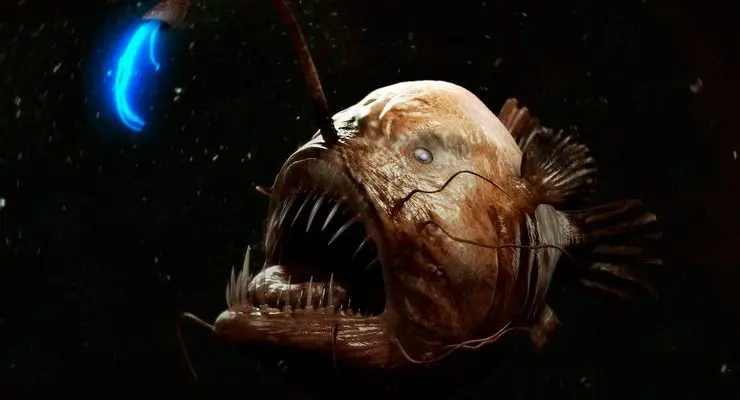
The monkfish or anglerfish represents the genus of ray-finned fish, the anglerfish family and the anglerfish detachment. This fish prefers to live at the bottom, where it is easy to burrow into the ground, while it almost completely burrows into it. Some individuals may be found among aquatic vegetation, including among placers of large rocks.
Sea devils: description
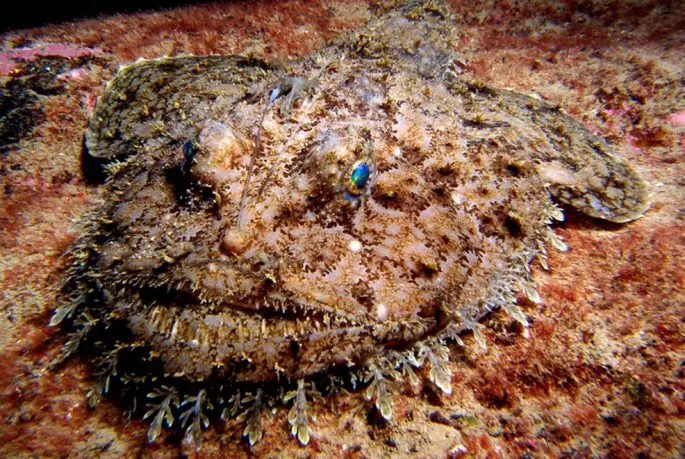
On both sides of the head of the monkfish, including along the edges of the jaws, as well as the lips, you can see the processes of the skin, in the form of a fringe. When these processes move in the water column, it seems that it is algae growing. In connection with a similar feature of the structure of the body, the fish is hardly noticeable against the background of the bottom.
Appearance

The European monkfish grows to almost 2 meters in length, although individuals are mostly found that are no more than one and a half meters long. The largest weight of adults is within 60 kg. The fish does not have scales, while its body is covered with numerous skin growths, as well as bone formations. The shape of the body is strongly flattened and slightly compressed in the back and belly. The eyes are not large and widely spaced on the head. The back is colored brownish, greenish brownish or reddish, with dark spots.
The American anglerfish grows to a length of 1 meter or a little more, and the average weight of adults is about 23 kilograms. The black-bellied anglerfish is a deep-sea fish that grows up to 1 meter in length and no more. The West Atlantic anglerfish is more modest in size and reaches a length of 0,6 meters, no more. The Burmese monkfish is characterized as a fish with a huge, strongly flattened head, as well as a short tail. Its length is less than 30% of the entire body length. Adults grow up to 1 meter in length.
Interesting to know! Monkfish is a rather interesting representative of the underwater world. The angler fish moves a little along the bottom, making peculiar jumps, which is possible due to the presence of strong pectoral fins.
The Far Eastern anglerfish is different in that it can grow up to one and a half meters, while it has a large, wide and flat head. Naturally, his mouth is simply huge, and the lower jaw is pushed forward somewhat, while several rows of teeth are located on it. This type of angler also has no scales, and the ventral fins are located at the beginning of the head. The pectoral fins are wide enough and have a fairly powerful blade. The first three rays that form the dorsal fin are located separately. The upper part of the body is distinguished by a brown tint, as well as the presence of white spots surrounded by a dark border. The lower region of the body has a characteristic light shade.
Character and lifestyle
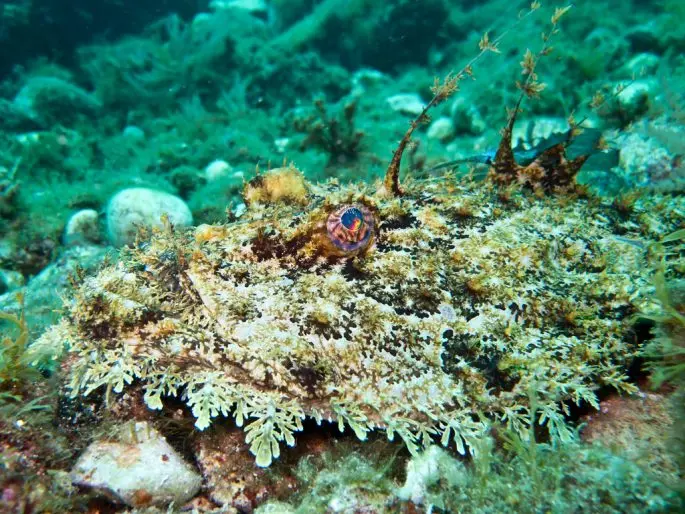
Scientists suggest that sea devils appeared on our planet about 100 million years ago. Despite this fact, these fish have not been fully studied. Therefore, it is not exactly known about the unique behavioral traits of these fish.
Interesting fact! The anglerfish hunts by making quick jumps, which are assisted by its powerful pectoral fins. If he overtook his victim, then he immediately swallows it with his huge mouth.
For a person, the monkfish does not pose any danger, especially since he prefers to live at a considerable depth. After spawning, the angler still rises to the surface and can pose a certain danger to divers. When a monkfish is hungry, it can easily bite a person by the arm or leg.
How long do anglers live
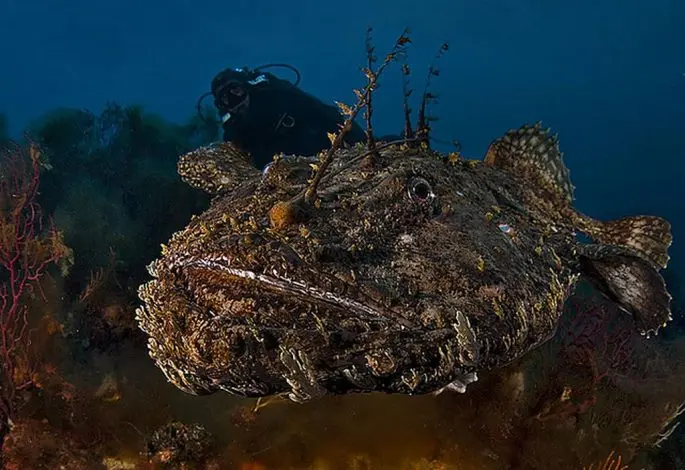
There is evidence that the American anglerfish lives on average for about 30 years, and the black-bellied angler is able to live in the natural environment for about 20 years. Cape monkfish live no more than 10 years.
IS AN LECK DANGEROUS FOR A HUMAN
Types of sea devils
The family of anglers is represented by several species, such as:
- American anglerfish (Lophius americanus).
- Black-bellied anglerfish (South European) or anglerfish – budegassa (Lophius budegassa).
- West Atlantic anglerfish (Lophius gastrophysus).
- Far Eastern anglerfish (Lophius litulon).
- European anglerfish (Lophius piscatorius).
There are also: the South African anglerfish (Lophius vaillanti), the Cape anglerfish (Lophius vomerinus), as well as the extinct species Lophius brachysomus Agassiz.
natural habitats
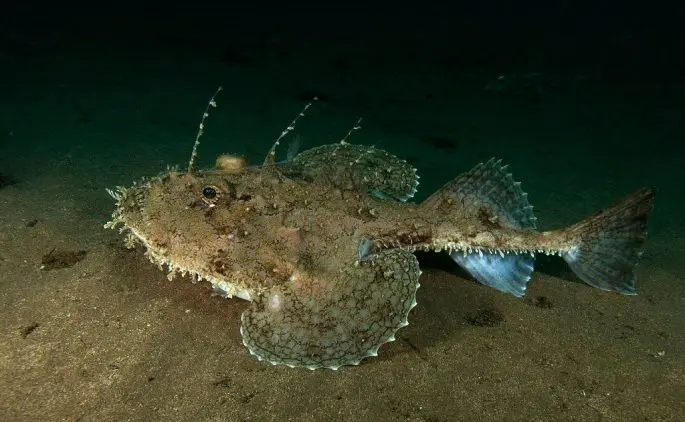
The black-bellied anglerfish can be found in the eastern waters of the Atlantic Ocean, between Senegal and the British Isles, as well as in the Black and Mediterranean Seas.
The West Atlantic monkfish lives in the western waters of the Atlantic, where it lives at depths up to 700 meters, adhering to the bottom area.
The American monkfish is found in the northwest Atlantic, which is typical of the North American coast of the Atlantic. The angler lives at depths up to 650 meters. Closer to the northern part of the coast, this fish does not adhere to great depths, but closer to the southern part – this fish is found even in the coastal zone.
The European angler inhabits the waters of the Atlantic Ocean, which wash Europe, from the Barents Sea and Iceland to the Gulf of Guinea, the Black, North and Baltic Seas.
The Far Eastern anglerfish is a representative of the waters of the Sea of Japan. It is also found off the coast of Korea, in the Gulf of Peter the Great, as well as within the island of Honshu. Some part of the population is distributed in the waters of the Sea of Okhotsk and the Yellow Sea, as well as the East China and South China Seas, including the Japanese coast of the Pacific Ocean.
The diet of sea devils

Basically, sea devils are in ambush, waiting for their next victim. As a rule, they almost completely burrow into the bottom soil and it is almost impossible to notice such a predator. The diet of anglers includes various types of fish, cephalopods, including cuttlefish and squid.
All sea devils, by the nature of their behavior, are classified as classic predators. In their stomachs, the remains of such living creatures as gerbils, small rays, cod, small sharks, flounder, etc. were found. Rising from the bottom closer to the surface, anglers hunt mackerel and herring. There were cases when anglers attacked feathered birds, which calmly moved on the surface of the water.
Important fact! When the angler opens its huge mouth, a low pressure is formed in the mouth, which sucks the victim in just a split second along with the flow of water.
The anglerfish has a unique body coloration, so it is difficult to see it even when it is just lying on the bottom. At the same time, he also burrows into the ground, putting out his angler (that’s why they called the fish an angler), at the end of which there is a luminous live bait that attracts various representatives of the underwater world that are included in the angler’s diet. When a potential prey is too close to the bait, the monkfish instantly opens its huge mouth, and the victim is immediately inside this mouth.
Reproduction and offspring
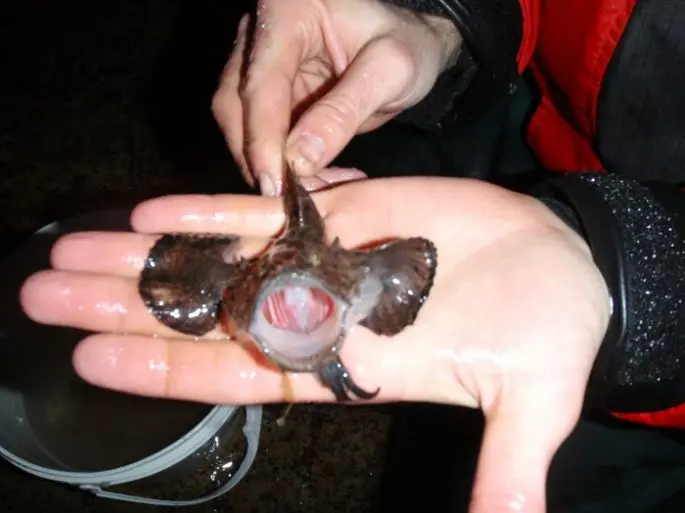
Different types of monkfish are also distinguished by the fact that they begin to breed at different periods of their lives. Males of the European anglerfish become sexually mature at the age of about 6 years, while females – when they reach 14 years old, growing up to 1 meter in length. European anglerfish and those spawn at different times: individuals living in the northern waters go to spawn in the month of March and spawning lasts until May, and individuals inhabiting the southern waters go to spawn in January, while spawning lasts until the beginning of summer .
When spawning begins at anglers, females and males can descend to a depth of up to 2 thousand meters. Having found a suitable place, the female begins to spawn, and the male immediately fertilizes it. After the spawning process, females and males leave the spawning grounds and go to shallow water, where they begin to actively feed. This process continues until the beginning of autumn. Sea devils overwinter at an impressive depth.
The fish lays eggs in peculiar ribbons, which are covered with a thick layer of mucus. Each type of anglerfish forms ribbons of a certain width and length. The average width of such a tape is 70 cm, and its length can be up to 10 meters. The thickness of such a tape is within 5 mm. The ribbons formed in this way move freely in the water column under the action of the force of the current. The laying of anglerfish is unique, since millions of eggs are located in one layer, at a certain distance from each other, while the eggs are located inside the mucous cells in the form of hexagons.
After the expiration of time, the walls of the cells are destroyed. Inside each egg there are fat drops that prevent the eggs from settling to the bottom. Therefore, the eggs continue to migrate in the water column. The fry of monkfish that have appeared have some differences from adults: they have not yet a flattened body, and the pectoral fins are relatively large.
After being born, fish fry rise to the upper layers of the water, where they will stay for about 2 weeks. The diet of juveniles includes small crustaceans that are found in the water column, fry of other fish species and pelagic caviar.
Interesting to know! The eggs of the European anglerfish are quite large and are about 4 mm in size, while in the American anglerfish it is quite small and reaches a diameter of up to 1,8 mm.
The process of growth and development of monkfish larvae is characterized by peculiar transformations, which is associated with changes in the structure of the body shape, which is inherent in mature individuals. Upon reaching a certain length, young individuals sink to the bottom. Grown up young growth can be found at medium depths, and sometimes near the coastline in the shallows. In the first year of life, monkfish have the most active growth, after which this process slows down.
Natural enemies of anglers
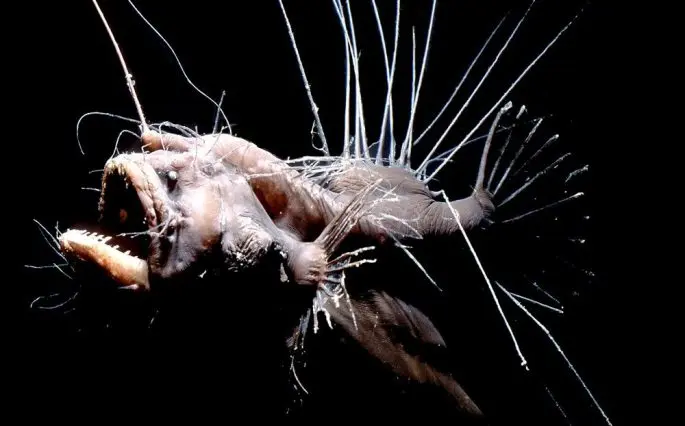
Anglerfish by their nature is considered a rather greedy and voracious creature, which often leads to their death. As mentioned above, the monkfish has a rather huge mouth, as is its huge stomach. Therefore, monkfish can hunt very large prey.
It is important to know! This fish has practically no natural enemies, since the monkfish can perfectly disguise itself, yes, and it lives at a considerable depth.
The anglerfish has large and sharp teeth that allow it to hold prey that may not fit in its stomach with a stranglehold. As a result of this greed, the fish often choke and die prematurely. There have been cases when prey was found in the stomach of a monkfish, which was almost commensurate with the size of the fish itself.
Population and species status
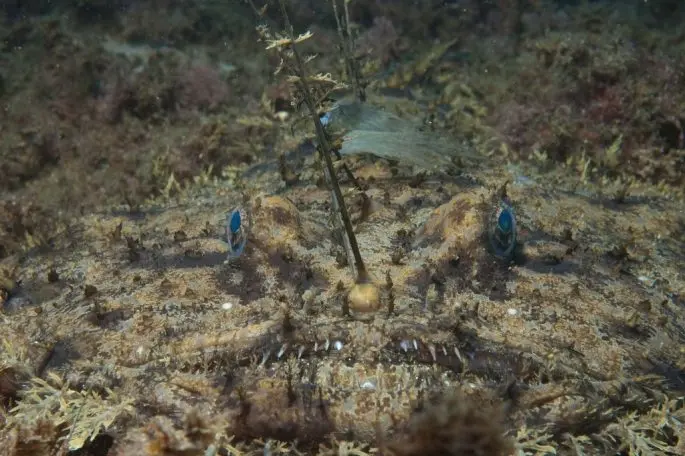
The European anglerfish is a popular food fish due to its white meat, dense texture and virtually no bones. Up to 30 thousand tons of this valuable fish are caught annually. Deep-sea trawls, gillnets and bottom longlines are used to catch it. The most massive catch is carried out within France and England.
Interesting fact! All anglers, including the European one, have an unattractive, and sometimes repulsive, appearance. Despite this, the meat of this predator has excellent taste data.
The meat of the anglerfish is not fatty, pleasant to the taste, tender and has a soft texture. Unfortunately, when butchering monkfish, most of the fish goes to waste, since the main value is the tail of the monkfish.
The West Atlantic anglerfish is also a valuable commercial fish, although it is caught much less than the European anglerfish, only about 9 thousand tons per year. This type of fish is mainly caught within Brazil. A few years ago, Greenpeace placed the American anglerfish on a special list of overfished and endangered seafood. Not only the meat of this fish is valued, but also its liver, which is considered a real delicacy. Thanks to such valuable qualities, the populations of monkfish began to decline significantly. In connection with this fact, in England it was forbidden to trade in the meat of sea devils.
Fiends – Deep Sea Anglerfish (Anglerfish)
Monkfish in cooking
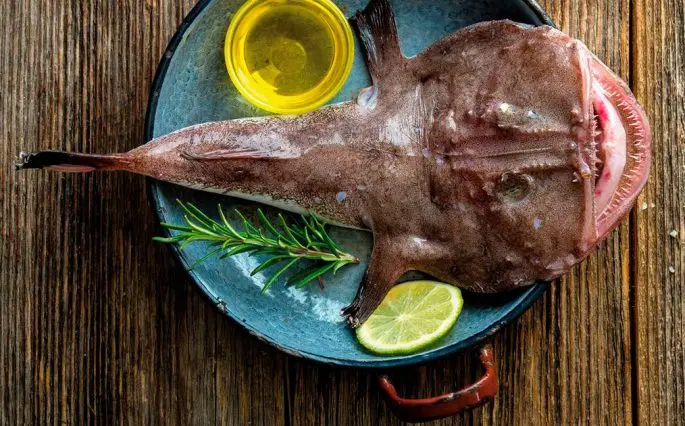
Monkfish meat is prepared using different technologies, which is absolutely acceptable. It is fried either whole or in pieces, as well as in the form of a shish kebab, when pieces of meat are strung on skewers. In addition, it is boiled and stewed. Anglerfish is especially popular in France, where it is prepared in various ways, such as with sweet yam or blackcurrant jam. The head of the monkfish is used for making rich soups with various seasonings.
No less valuable is the meat of this fish for the Japanese, who use monkfish with little to no waste: they eat meat, liver, fins, skin and even the stomach.
The Chinese also love wok-cooked monkfish meat. To do this, they take a fish fillet and fry it in oil with the addition of rice vinegar and soy sauce, sprinkling it with ginger and chili peppers. After that, the wok is removed from the heat and coriander and green onions are added to the dish. Then it’s all mixed and eaten with rice. Many who managed to try this dish noted the presence of a smoked flavor. In fact, this is a consequence of the action of spices and the peculiarities of cooking on a wok. Due to the quick frying, the meat is quite juicy and tender.
Americans prefer grilled monkfish, with the fish cut into pieces, along with the skin and backbone. The meat is then marinated in olive oil, rosemary and salt. The use of oil allows you to keep the juiciness of the meat. Meat is served with grilled vegetables seasoned with olive oil and lemon juice. Americans also cook meatballs from angler meat and eat them with carrot puree.
In Korea, the national dish Hye is prepared from meat, which is a spicy and, at the same time, sweet soup, in which there are a lot of vegetables, after which monkfish fillet fried in batter is added to it. In addition, the meat is seasoned with hot spices and put into rice dough, after which such “pancakes” are fried in a large amount of oil. Monkfish prepared in this way are eaten with soy sauce.
Monkfish restaurants serve gourmet cuisine. The fish is fried and served with a sweet and sour sauce or with lemon or lemon zest, and possibly with a parsley or spinach sauce with cheese. At the same time, fish can be fried with the addition of hot chili peppers, smoked paprika, ginger, cooked with white wine, cream sauce, milk, baked with tomatoes, and also cooked by stringing rosemary on sprigs, etc.
Since the fish is under the protection of many states, it is almost impossible to freely buy it in stores. If the monkfish appears on the shelves of some stores, then at a very high price, and then, at a certain time of the year. The average cost of a monkfish is up to 20 euros per 1 kg of fish.
Monk fish recipe. Fish in batter. How to cook fish Monkfish (Anglerfish)









